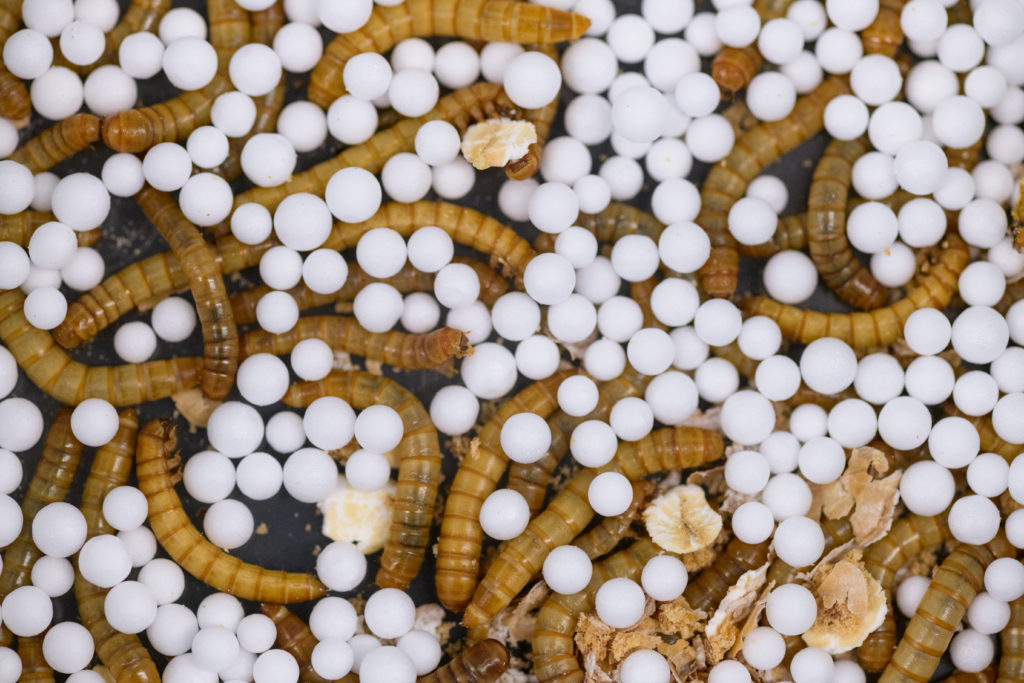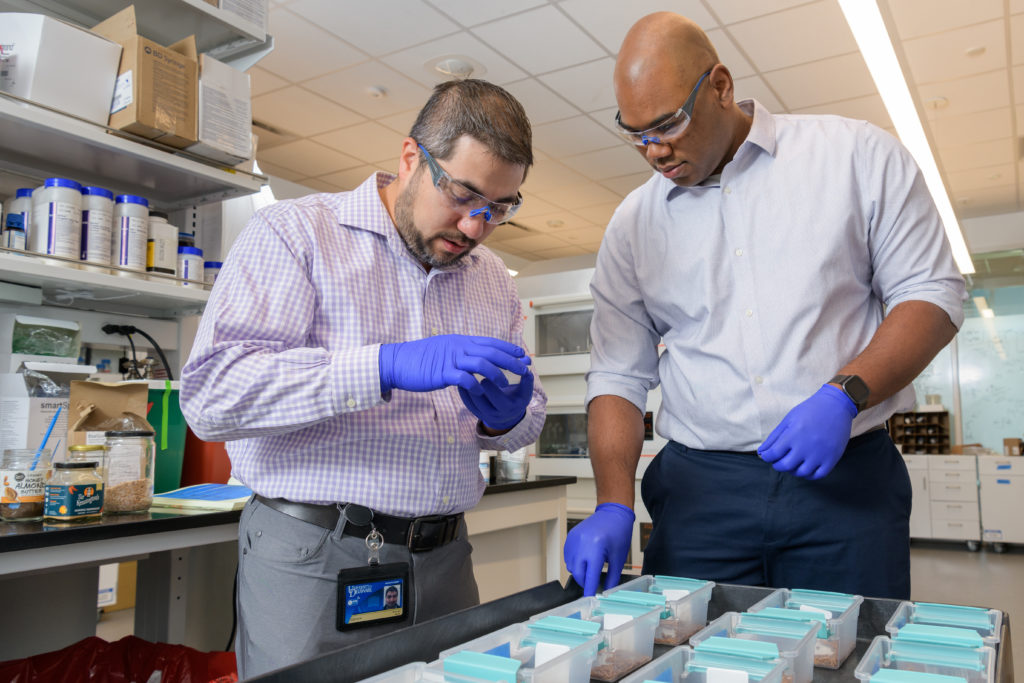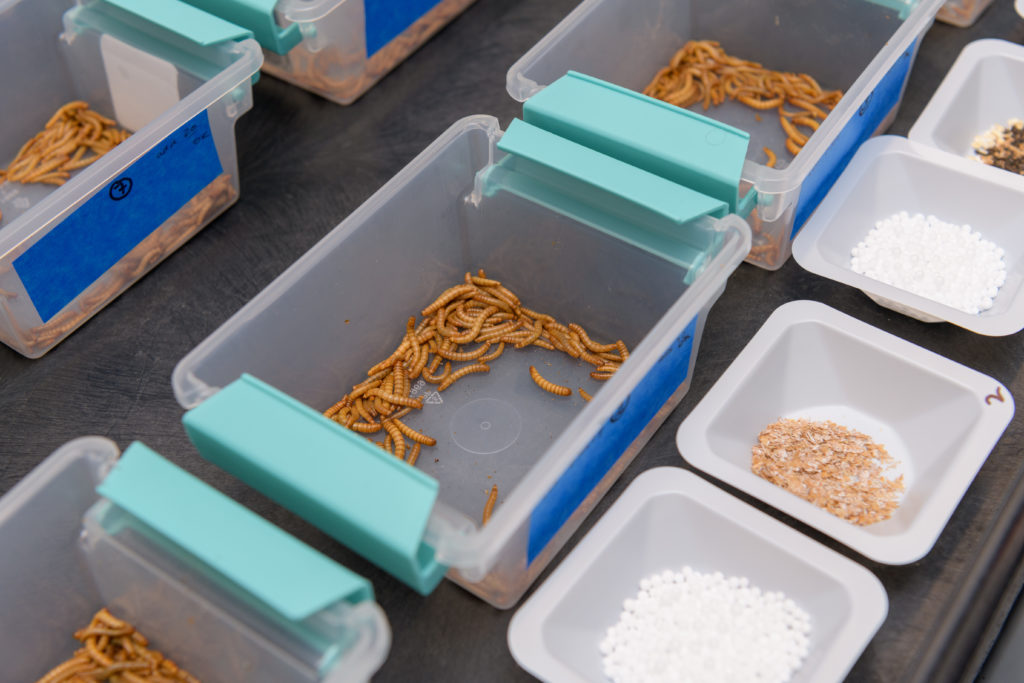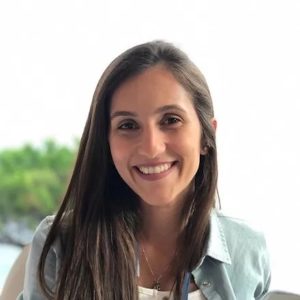We know all kinds of things about plastic – except, how to break it down for recycling. But some hungry insects can digest plastic. So researchers are taking a look at how these critters process plastic, to improve plastic recycling by following their lead.
The Joint Genome Institute presents the Genome Insider podcast. Find show notes here.
Episode Transcript:
Menaka: To start off today’s episode, I’m at my local pet store.
Because there’s a creature here that’s found in most pet stores, that could help us with a big puzzle that we struggle to solve, even as it becomes a bigger problem every day: plastic waste. This pet store critter can eat plastic, and break it down.
So with help from this animal, and the JGI, researchers are looking for better ways to recycle plastic. And before we meet our creature friend, here’s a hint: It’s not actually a pet. Usually, it’s a snack for other pets.
Cody Fort: Mostly it’s lizards. Bearded dragons, leopard geckos, chameleons, frogs will eat them as well.
Menaka: Cody Fort is the animal care lead here at the pet store. While he brings me over to our mystery critter, the researchers working on this project have a few more clues about what it is.
Ross Klauer: For somebody who hasn’t seen it before, I mean, they’re just real small. Like, I mean, probably like two, three centimeters,
Lummy Monteiro: A bit yellow.
Mark Blenner: similar looking structure, probably a little less, um, attractive than an inchworm,
Menaka: These researchers also get their animals from a reptile feed store.
Mark Blenner: and they just come in like a container, like a Chinese food container.
Menaka: Which brings us to our big reveal. <<container opens>>
Menaka: So there they are!
Cody Fort: Yeah. These are the mealworms.
Menaka: That’s right. We’re talking mealworms.
Cody Fort: They look like little hard shelled caterpillars,
Menaka: And here, they’re just wriggling around in their container. But in the lab, they’re ready to help recycle plastic. So let’s get into that.
<<music>>
Menaka: This is Genome Insider! Where we tag along with JGI-supported researchers who are studying all kinds of things, and see how their work could advance clean energy and protect our environment. I’m your host, Menaka Wilhelm.
Today, we’re meandering our way into a mealworm corral at the University of Delaware, because researchers there are looking at what mealworms have to teach us about recycling plastic.
<<music>>
Menaka: In the last hundred and fifty years, we’ve fine-tuned plastic into a perfect waste problem. It’s cheap enough to use all over the place, and it’s sturdy enough to stick around. But even as we’ve developed new plastics to use in more ways, our ability to reuse and recycle this material has mostly… stayed about the same.
As humans, we’re way better at making new plastic than we are at breaking down old plastic.
Part of our problem, is that chemically, it’s easiest to recycle one thing at a time. Like glass, or steel, or aluminum, or paper. Plastics, on the other hand, are more of a posse than a single player. Most plastics are a mix of chemicals to begin with – so different polymers, and pigments for color. And along the way a plastic picks up remnants of whatever it contains – whether that’s laundry detergent or shredded cheese. And we use lots of different plastics. So by the time our plastics are ready to be recycled, they’re a whole medley of materials. A big challenge for any kind of machine.
Kevin Solomon: However, biology is very good at processing these mixed things.
Menaka: Kevin Solomon is one of the researchers leading this project at the University of Delaware. And in this case, biology brings us back to our mealworm friends. Because mealworms are excellent eaters. They’re actually larvae – they grow up to be mealworm beetles. And in the wild, these mealworm larvae chomp their way through grains, dead bugs, and mostly – leaves. Which turn out to be a bit like plastics.

These mealworm larvae will chomp their way through these plastic balls, breaking bigger chemical groups into smaller ones. (University of Delaware/Evan Krape)
Plants coat their leaves in waxy, water-resistant coverings to protect them. And hungry mealworms have no problem digesting these leaves – coating and all – making them the perfect insects for this project.
Kevin Solomon: We’re going from like, yeah, we need to get rid of plastics. What is a plastic-like thing? Leaves. What breaks down leaves? Worms – let’s figure out how they do it and can they do plastics as well?
Menaka: The answer is yes.
Kevin Solomon: So not only is there the potential for a biological solution that can help us get rid of our plastic problem, but we would also overcome the challenge of sorting and cleaning plastics, which is also part of the reason why these things are not economical.
Menaka: Mealworms are a great starting point. But it turns out, mealworms rely on other organisms in their bellies to digest these plastics. Here’s Mark Blenner, the other University of Delaware researcher leading this project:
Mark Blenner: The microbes in the gut are actually what provide the chemical transformation of the plastics.
Menaka: So mealworms do the initial chomping, but it’s bacteria and fungi in their guts – the mealworm gut microbiome – that are the real MVPs here.
And that actually opens up even more options for breaking down plastic in new and better ways. It could mean creating a microbial mixture that digests plastic, or formulating a mixture of the enzymes that microbes use to break things down.
Mark Blenner: Basically, we’re trying to remove the worm from the process.
Menaka: That’s the eventual goal – but in this part of their research project , the worms are very much part of the process. This team is taking a look at their guts, to tease apart which microbes are involved in plastic processing.

Mark Blenner (left) and Kevin Solomon (right) take a look at the mealworms that will be munching plastic. (University of Delaware/Evan Krape)
<<music>>
Menaka: So if you want to zoom in on the plastic-processing part of the mealworm microbiome, you set up an introduction. Mealworm gut microbes, meet plastic. Then, you take a look at which microbes thrive on plastic. Lummy Monteiro is a postdoc who sets up these microbe-plastic intros – by feeding mealworms plastics.
Lummy Monteiro: So basically, we can compare what type of bacteria and fungi are growing, based on the plastic and also based on the food supplementation that we provide to them.
Menaka: Plastic alone is not a super well-balanced diet. So this team also provides nutrients to keep the mealworms going. The plastic part of their diet comes in the form of small, round plastic balls. Think of a very tiny ping pong ball – but these balls are solid, not hollow.
Lummy Monteiro: For example, we have like, polystyrene styrofoam balls that we basically put there.
Menaka: For these experiments, the mealworms live in clear boxes in the lab – kind of like a little clear shoebox. They live there, and they also eat there. So in each plastic case, there are both a bunch of mealworms, and a bunch of little plastic balls. It looks a bit like a giant sea of plastic balls where kids might play – like a ball-pit for mealworms.
Lummy Monteiro: And then after like seven days, these balls start to basically disappear.
Menaka: Because the mealworms and their microbes are chomping away! Up close, it’s even possible to see little tiny munch marks out of these balls.
Lummy Monteiro: So if you see, like a picture of a before and after, I mean, the playground just disappeared, you know?!
Menaka: And while these mealworms eat up the plastics, some of their gut microbes thrive. These microbes may not all be doing the same stuff – but some of them, at least, are taking big chemical groups of the plastics and chopping them into smaller pieces. PhD student Ross Klauer also works on this project, and he can imagine that all kinds of different microbes are doing different things here, chemically.
Ross Klauer: A set of microbes that are probably breaking down carbon, carbon bonds and different microbes that are doing,you know, working with the smaller pieces of polymer and, you know, maybe turning those into something useful, like an alcohol or an -aldehyde.
Menaka: But solving the mystery of which microbes are doing what – is a big job. Some of these microbes might be new, or rare species. They could be using enzymes we don’t know even about yet – so the first stop in this project is to take a look at all the microbes present when a mealworm eats plastic.
Ross Klauer: That’s why the JGI is gonna be so helpful as part of this project to give us that massive amount of sequencing data where we can just dig in and see, yeah, these, you know, these couple organisms are really showing up every time that we’re feeding the worms, the plastic.
Menaka: As part of this project, the JGI is analyzing whole mealworm microbiomes to see which microbes are around, and what kind of tools they’re working with. For microbes, that’s what genes they have, and what proteins they can make. This is a metagenome sequence – it captures all of the genetic material from the entire mealworm gut. That means dissecting whole mealworm guts, also called a gut extraction. Here’s Lummy again.
Lummy Monteiro: So we do the gut extraction in our lab. We do the DNA extraction as well.
Menaka: And then, they send the sample off to the JGI, where JGI researchers do the prep and sequencing.
Lummy Monteiro: The important data that we will have, it will come from JGI. I mean, it is coming right now, actually. And we are already excited about the results and we are analyzing all the data right now.
Menaka: And even better, this team will also be getting data from another user facility, too – the Environmental Molecular Sciences Laboratory out of Pacific Northwest National Lab. They’ll send back information on the proteins these microbes are using to degrade plastic. So – what proteins these mealworm microbes are making, how much of those proteins, and when they’re making those proteins – that is the metaproteome.
We’ll get back to all of that data in just a bit. First, we’re switching gears and taking a break.
<<music>>
Menaka: This episode is all about mealworm guts. And the JGI has helped many other researchers study many other kinds of guts. Cows, termites, the Amazonian stinkbird, the hoatzin – which, is the only bird that uses a multicompartment gut to digest its food. Find out more on our website.
<<music>
Menaka: And now, it’s time for a quick bit of acronym action. Because the words for science are long, and many – and it’s only natural that we shorten those words down with acronyms. So the question is, how guessable are those acronyms?
<<music>>
Menaka: Today, I’ll be quizzing Rekha Seshadri.
Rekha Seshadri: Hi Menaka, I’m Rekha, I’m a data scientist at the Joint Genome Institute. I do a lot of comparative genomics analysis of bacteria, and microbiomes, so community of microbes that do exciting things in the environment, like bioremediation, or as sentinels of climate change. That sort of thing.
Menaka: Awesome. Well we have a great acronym for you to guess today. So the acronym is EPICON, that’s E-P-I-C-O-N. And I’ll give you four options. Does EPICON stand for,
- Ectomycorrhizal Processing of Carbon and Nitrogen
- Epic Penguins Inquiring about Conifers
- Epigenetic Control of Drought Tolerance in Sorghum
- Enterobacter Production of Chemicals or Nanomaterials
Rekha Seshadri: Well obviously the second one is wrong. I feel like it’s number 4 because I’m less familiar with this acronym. I feel like, that it’s number 4.
Menaka: Alright. Well let’s hear from our revealer.
Peggy Lemaux: I’m Peggy Lemaux, I’m in the department of plant and microbial biology at UC Berkeley and I have worked on every possible cereal grain there is.
Rekha Seshadri: Oh, no <laughs>
Peggy Lemaux: EPICON stands for epigenetic control of drought resistance in sorghum.
Menaka: So the EPICON is the first two words, the EPIgenetic CONtrol. And that’s where you get the EPICON.
Rekha Seshadri: Wow.
Menaka: Here’s a bit more about that project.
Peggy Lemaux: Sorghum is extremely drought tolerant. And we wanted to understand how, how it is that that crop, versus let’s say maize, which is a close relative. How is it that sorghum is so drought tolerant. And so that was the focus.
Menaka: And you can learn even more about the EPICON project on our website.
Menaka: If you’re a top notch acronym guesser, or, you have a JGI related acronym that would be fun to guess? Send us a note at [email protected], and we’ll get back to you!
<<music>>
Menaka: Before we return – a quick announcement!
The JGI is a taxpayer-supported user facility. So supporting all kinds of scientists’ work is what we do. We have projects in genomic sequencing, synthesis, transcriptomics, metabolomics, and natural products, in all sorts of non-human organisms.
To work with us, scientists can submit proposals to the JGI Community Science Program.
Right now, we’re looking for projects in Functional Genomics. Maybe you’re looking at genes and pathway synthesis, strain engineering, metabolomics, or plant-microbe interactions? Submit a proposal – they’re reviewed twice a year!
You can find more information about each of these at jgi.doe.gov/user-programs. That’s jgi.doe.gov/user-programs.
<<music>>
Menaka: And now, back to our mealworm microbiomes. Let’s first just do a quick recap of how this project goes from feeding mealworms plastics to improving plastic recycling. Here’s Kevin Solomon, one of the project leads, starting at the plastic-eating part.
Kevin Solomon: You essentially lay out a buffet of plastics, and then you see which microorganisms come to the party and proliferate and, and eat these plastics and grow,

In rows of plastic boxes, this team is able to compare how the mealworm gut microbiome handles different conditions, and different kinds of plastics. (University of Delaware/Evan Krape)
Menaka: Then, you take inventory of who arrived. That’s where the JGI comes in – with metagenome sequencing. Essentially, that gives you a readout of the entire mealworm gut microbiome.
So if you think of the mealworm microbiome as a pond, sequencing the metagenome is a little like casting a giant net in that pond.
Kevin Solomon: The JGI has been very instrumental in helping us identify what microbes are in this net. So trying to figure out who we’ve called to the table.
Menaka: That helps answer lots of questions about how this plastic processing works. And on top of that, there’s a tricky match up to figure out: Which microbes from that big net break down specific plastic molecules?
To work that out, Kevin and this team are taking a more targeted approach in the pond of this microbiome – it’s much more like casting a single fishing line. So putting specific bait on a hook, throwing it into the microbiome pond, and seeing which microbes bite.
And to bring our analogy back to the lab, the microbiome pond is an extraction from mealworm guts – a sample of all the microbes around. And that special bait on the fishing hook is something called a chemical probe. Chemical probes are small molecules that are specially made of different chemical groups. Here, they’ll make it possible to fish out microbes that break down specific parts of plastic molecules.
For this part of the project, Kevin and Mark are turning to a chemical probe expert at Pacific Northwest National Lab (Aaron has since accepted a faculty position at Baylor University).
Aaron Wright: That’s me. I’m Aaron Wright.

Aaron Wright, formerly at PNNL, currently at Baylor University (Andrea Starr | Pacific Northwest National Laboratory)
Menaka: Aaron uses synthetic organic chemistry to make these probes. And if we go back to our fishing line analogy, a good probe and a baited fishing line have the same three main parts.
First, a fishing line needs bait – something to attract a catch. In a chemical probe, that’s called a finder group. Here, it’ll be a little chemical that a plastic-eating microbe would want to munch, because it kind of looks like a plastic.
Aaron Wright: It guides the probe to the microbes and the enzymes that are responsible for reacting with the plastics.
Menaka: Because the microbes use enzymes to munch the plastics. Then, you need a hook, to capture your catch. In a probe, that’s called a reactive group.
Aaron Wright: It forms a covalent or permanent bond between the probe and the protein so that we can eventually fish out those probe-captured proteins.
Menaka: And finally, you need a way to reel in what you’ve caught. Instead of a fishing line, a chemical probe has a reporting group. Sometimes these are bits that fluoresce, other times they’re little chemical tags that researchers have ways of sorting out.
Aaron Wright: And now you can make measurements using the reporting group, whether they’re fluorescence, or -omics based, or whatever it might be.
Menaka: So the approach here is to cast a metagenomic net, and also reel in specific microbes with chemical probe lines that catch them by their enzymes. Sounds great, and it is – but there is still a tricky part, because microbiomes are extremely complex. Here’s Mark Blenner again.
Mark Blenner: So we know that the plastics are undergoing some sort of a chemical degradation process.
Menaka: And it’s microbes that are breaking that plastic down in different steps – but different microbes might be dismantling different parts of the plastic along the way. So to fish for those microbes, you want to bait your hooks pretty specifically.
Mark Blenner: In some ways you want probes that mimic, all of the steps of this chemistry, which we don’t know yet.
Menaka: So there’s a bit of a tricky circular process here – knowing more about the microbes and enzymes that munch plastics, will make it easier to fish for them in the microbiome. And fishing these microbes out of the microbiome will make it easier to figure out which ones are munching which plastic bits.
Setting up these designs is an iterative process. Each design round will make it more clear how to bait these chemical probes well.
And here, this team of researchers will also get clues from another user facility that’s part of this project – that lab we mentioned before the break, the Environmental Molecular Sciences Laboratory. They’ll help highlight which enzymes the microbes are using to break down plastics.
Mark Blenner: We can then pick out the important microbes and start interrogating, you know, what are the proteins that they’re making, and then connecting them back to the genetics, the genome sequences that, um, JGI is collecting.
Menaka: Mark and Kevin are looking at this system with both a broad view, and a narrow view, to make sense of what’s happening.
Kevin Solomon: So ultimately the goal is to design a bio-process that is scalable and cheap, that can degrade different plastics.
Menaka: So, maybe a cocktail of microbes that could break plastics down in a series of steps, or a mix of enzymes to do the recycling instead. And that sounds pretty lofty, but it could be within reach. This is exactly the kind of problem that Kevin’s lab has set out to tackle.
Kevin Solomon: We’re kind of like Jurassic park in that we acknowledge that life finds a way.
Menaka: As humans, we figured out how to create plastic – and so there are ways to degrade it, too. Not that breaking down plastic is necessarily easy –
Kevin Solomon: This is not straightforward, because if it were widespread, then we wouldn’t have a plastic pollution problem in, in the first place.
Menaka: But somewhere in the world’s biological toolbox, there’s likely a solution.
Kevin Solomon: Biology has had a couple thousand years, actually a couple million years head start on human civilization,
Menaka: Which is plenty of time to address a really wide range of problems. So whatever the issue,
Kevin Solomon: Biology, almost certainly, has already addressed it and solved it.
Menaka: It’s our job to find out how, and build on that.
<<music>>
Menaka: That wraps up our meander into the mealworm microbiome metagenome! We’ll be back in a month with a way that researchers are studying plants – by zooming in on single cells.
This episode was written and produced by me – Menaka Wilhelm, with production help from Massie Ballon, Allison Joy, David Gilbert, and Ashleigh Papp.
Special thanks to Cody Fort and Joe Morton at Pets on Broadway, in Portland Oregon – that’s where I met the mealworms in the beginning of this episode! And many thanks to our researchers, Kevin Solomon, Mark Blenner, Lummy Monterio, Ross Klauer, and Aaron Wright.
If you liked this episode, help someone else find it! Tell them about it, send a link over, or leave us a review wherever you’re listening to the show.
Today’s research story is supported by a collaborative science initiative between the JGI and the EMSL. These are both national user facilities supported by the DOE Office of Science, Office of Biological & Environmental Research.
And the collaborative program supporting this project is called FICUS. That stands for Facilities Integrating Collaborations for User Science. The FICUS accepts projects through an Open Call for Proposals – this year’s call has closed, but you can find out more about the program on our website.
Genome Insider is a production of the Joint Genome Institute, a user facility of the US Department of Energy Office of Science located at Lawrence Berkeley National Lab in Berkeley, California.
Thanks for tuning in – until next time!
Show Notes
- Sequencing the Amazonian Stinkbird’s Microbiome
- Acronym Action: EPICON project
- Submit a proposal to work with the JGI!
- Find out more about the FICUS program between JGI and EMSL
- Integrated Microbial Genomes and Microbiomes
- Our contact info:
- Twitter: @JGI
- Email: jgi-comms at lbl dot gov

